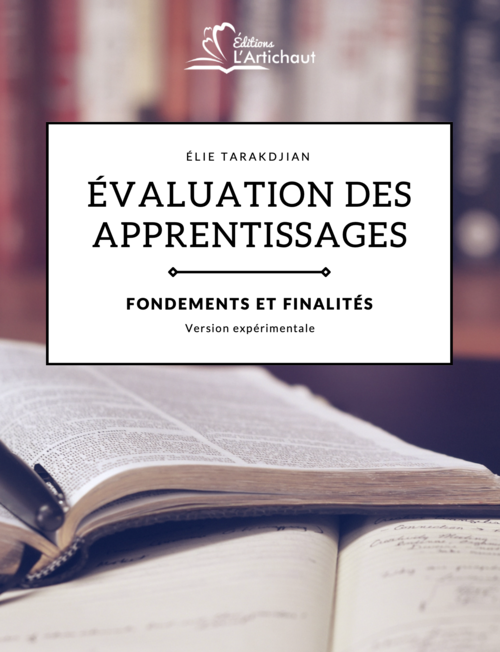Version without download | Gathering Evidence of Learning published by L'Artichaut Editions| Available exclusively in French - copie
For a fraction of the price, here's the non-downloadable PDF version.
"Learning Assessment: Perspectives and Objectives" by Élie Tarakdjian marks a significant evolution in the educational field in Quebec, redefining the perception and implementation of teaching and learning.
Published by Artichaut Editions, this more affordable version, excluding the option to download documents, continues to offer a thoughtful, student-centered analysis. The work emphasizes the importance of seeing the learner not only as a passive recipient of information but also as an active contributor to their own education.
In the first chapter, the author explores a variety of essential knowledge for teachers, divided into three major categories. These include observations of the school and sociocultural environment, experimental studies on the learning process, and the impact of this knowledge on pedagogy and learning. Tarakdjian discusses theories such as constructivism, socio-constructivism, connectivism, and the correlation between the educational program and the new pedagogical model, highlighting the inseparable union of teaching, learning, and assessment.
The second chapter focuses on the methods of learning assessment, distinguishing between measuring and evaluating, and providing a concrete definition of the latter. It also identifies four crucial aspects to improve evaluative interventions and examines assessment in various contexts, including knowledge acquisition and skill development.
The third chapter concentrates on the evaluation process, with particular emphasis on planning. Tarakdjian discusses different evaluative approaches and methods for interpreting data, underscoring the necessity of differentiated pedagogy and its implications for the teacher.
The fourth chapter deals with the collection and analysis of information in the evaluative process. It addresses data collection, information sources, informal or spontaneous assessment, and the use of checklists as formative tools.
The fifth chapter focuses on collecting information for summative purposes, examining tools such as questionnaires, evaluation grids, and interviews, with an emphasis on Bloom's Taxonomy and its application in a competency-based framework.
The sixth chapter is centered on interpreting and communicating evaluative information, covering topics such as decision-making during learning, result communication, and the use of portfolios in the school context.
Finally, the seventh chapter explores the relationship between evaluative methods and student motivation, discussing the perception of the value of school tasks, competencies, and students' mastery in their educational environment.
Throughout these chapters, Tarakdjian sheds light on the complexity of learning assessment, offering a valuable guide for educators seeking to master this essential but often misunderstood field. He advocates for a comprehensive educational approach, uniting teaching, learning, and assessment around the student.
- ISBN: 978-2-924987-17-9
- Format: Digital Book
- Éditions L'Artichaut
- Élie Tarakdjian
Introduction
| Titre |
|---|
Couverture en couleurs |
Couverture |
Crédits |
Avertissement |
Contenu |
Contenu |
Introduction |
Chapitre 1
| Titre |
|---|
Chapitre 1 | page 7 |
Chapitre 1 | page 8 |
Chapitre 1 | page 9 |
Chapitre 1 | page 10 |
Chapitre 1 | page 11 |
Chapitre 1 | page 12 |
Chapitre 1 | page 13 |
Chapitre 1 | page 14 |
Chapitre 1 | page 15 |
Chapitre 1 | page 16 |
Chapitre 2
| Titre |
|---|
Chapitre 2 | page 31 |
Chapitre 2 | page 32 |
Chapitre 2 | page 33 |
Chapitre 2 | page 34 |
Chapitre 2 | page 35 |
Chapitre 2 | page 36 |
Chapitre 2 | page 37 |
Chapitre 2 | page 38 |
Chapitre 2 | page 39 |
Chapitre 2 | page 40 |
Chapitre 3
| Titre |
|---|
Chapitre 3 | page 53 |
Chapitre 3 | page 54 |
Chapitre 3 | page 55 |
Chapitre 3 | page 56 |
Chapitre 3 | page 57 |
Chapitre 3 | page 58 |
Chapitre 3 | page 59 |
Chapitre 3 | page 60 |
Chapitre 3 | page 61 |
Chapitre 3 | page 62 |
Chapitre 4
| Titre |
|---|
Chapitre 4 | page 79 |
Chapitre 4 | page 80 |
Chapitre 4 | page 81 |
Chapitre 4 | page 82 |
Chapitre 4 | page 83 |
Chapitre 4 | page 84 |
Chapitre 4 | page 85 |
Chapitre 4 | page 86 |
Chapitre 4 | page 87 |
Chapitre 4 | page 88 |
Chapitre 5
| Titre |
|---|
Chapitre 5 | page 109 |
Chapitre 5 | page 110 |
Chapitre 5 | page 111 |
Chapitre 5 | page 112 |
Chapitre 5 | page 113 |
Chapitre 5 | page 114 |
Chapitre 5 | page 115 |
Chapitre 5 | page 116 |
Chapitre 5 | page 117 |
Chapitre 5 | page 118 |
Chapitre 6
| Titre |
|---|
Chapitre 6 | page 153 |
Chapitre 6 | page 154 |
Chapitre 6 | page 155 |
Chapitre 6 | page 156 |
Chapitre 6 | page 157 |
Chapitre 6 | page 158 |
Chapitre 6 | page 159 |
Chapitre 6 | page 160 |
Chapitre 6 | page 161 |
Chapitre 6 | page 162 |
Chapitre 7
| Titre |
|---|
Chapitre 7 | page 179 |
Chapitre 7 | page 180 |
Chapitre 7 | page 181 |
Chapitre 7 | page 182 |
Chapitre 7 | page 183 |
Chapitre 7 | page 184 |
Chapitre 7 | page 185 |
Chapitre 7 | page 186 |
Chapitre 7 | page 187 |
Chapitre 7 | page 188 |
Bibliographie
| Titre |
|---|
Bibliographie | page 190 |
Bibliographie | page 191 |
Quatrième de couverture |
